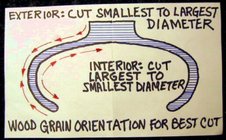This post by @odie got me thinking. If your cuts are not a clean as you like, how can you tell if it’s a presentation or a sharpness issue? (Or both!) Which one has a bigger impact on the cut?
I was working on some hemlock today, which has very soft wood between hard growth rings. Like pine but worse. I was getting horrible deep tear out in the soft part of the rings using my bowl gouge. Only way I could clean it up was by dozens of very light shear scraping passes, sharpening often.
I was working on some hemlock today, which has very soft wood between hard growth rings. Like pine but worse. I was getting horrible deep tear out in the soft part of the rings using my bowl gouge. Only way I could clean it up was by dozens of very light shear scraping passes, sharpening often.
This is very much like those who swear their tools are sharp, when it's obvious their results require much more sanding than would have been necessary if the hypothesis were true.....
-----odie-----

